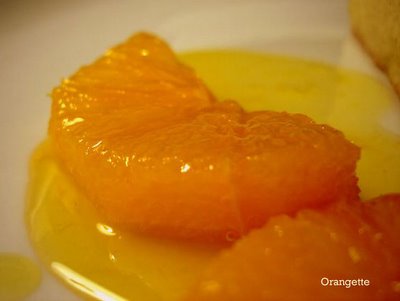A girl, a grocery store, a cake with glazed oranges
I am a glutton for the grocery store. I come by it honestly, inevitably, hereditarily: my father was an eager grocery store goer, as is my mother, and so is my sister. I remember the grocery stores of my childhood as though they were people: Skaggs Alpha Beta, clean and cold, with cardboard bins of potatoes and myopic cashiers; Safeway, with its Saturday gift of greasy donuts in waxed paper bags; and Crescent Market, its entryway smelling of smoked meats, its soft carpet, silver dish of butter cookies, and blue velvet sofa. For me, going to the grocery store is less about buying than it is about being there, less shopping than a sort of sensory steeping. The grocery store is not only a place for purchasing, but also for observing, for ogling, for stacks of crisp-smelling boxes, bright colors, and big ideas. It is a place of promise, neatly presented, aisle after aisle, edible and otherwise. There I have found, at one time or another, nearly everything necessary for modern life, including a job, a boyfriend, and, once, a friendly but fortunately one-night stand.
I love the grocery store.
These days, I find myself pulled to the produce section, where spring is sending up its first February shoots. Never mind winter and adverse weather: the artichokes have arrived, impatient for their bath in clarified butter, and the avocados wait eagerly to slip into a salad, a sandwich, or guacamole. The radishes are plump and ruddy-cheeked, the beets small and dirt-smeared. Even the early-season strawberries are fine, with their light, fuzzy coats and long stems. But the vedette of fruits and vegetables is surely the orange, the swath of gold that falls upon the produce section each February, and for all too short a time. I wait all year for them: the navel, the heirloom navel, the Seville, the blood, the Cara Cara, each heavy in the hand and juicy to the tooth, thin-skinned, sweet, and spicy. I snatch them up, six at a time, and back at home, I hoard them. I stand over the sink to eat them out of hand; I supreme them for salads, and I squeeze them into soup. And recently, I’ve been simmering them in syrup and serving them alongside a vanilla bean buttermilk cake.

This cake is plenty good on its own—moist, rustic, and rich with vanilla—but with a soak in citrus syrup and a few segments of sugar-swollen orange, it begs for a second serving.
A quick dip in a bubbling bath of juice and sugar turns the average orange from very good to glazed, glassy-eyed, and great. Though sweet, each slice still holds a measured shot of acidity, which jostles good-naturedly against the round, familiar flavor of vanilla. This is a Creamsicle for grown-ups in cake form, juicy, sophisticated, and slurp-worthy. It makes a good excuse for a trip to the grocery store, and if you’re wise—or very, very wise—a clean sweep of the produce section.
Vanilla Bean Buttermilk Cake with Glazed Oranges
Inspired by Alice Medrich’s Chocolate and the Art of Low-Fat Desserts and Martha Stewart’s What to Have for Dinner
The components of this pairing come from two different desserts, but now that I’ve tasted them together, I’m loathe to ever separate them again. The cake is dead-easy; the oranges are even easier; and together they’re pretty drop-dead delicious. Be sure to choose a vanilla bean that is moist and plump, and make certain that the oranges feel heavy for their size and taste sweet, as they do in the peak of their season.
For the cake:
1 ½ cups unbleached all-purpose flour
¼ tsp baking powder
¼ tsp baking soda
A pinch of salt
3 large eggs
1 vanilla bean, about 6 inches in length
½ cup buttermilk
5 Tbs unsalted butter, at room temperature
1 cup granulated sugar
For the oranges:
4 medium to large navel oranges
½ cup granulated sugar
Preheat the oven to 325 degrees Fahrenheit, and position a rack in the lower third of the oven. Grease an 8-inch round cake pan.
In a medium bowl, whisk together the flour, baking powder, baking soda, and salt. In a small bowl, beat the eggs with a fork to break up the yolks and mix them thoroughly with the whites. Set the dry ingredients and eggs aside.
Using a sharp knife, split the vanilla bean from stem to tip, and use the back edge of the knife to scrape the beans from the pod. Pour the buttermilk into a measuring cup or small bowl, and add the vanilla beans, whisking thoroughly to break up any clumps.
Cut the butter into a few chunks, and place it in a large mixing bowl. Beat on low speed for a minute or so, to soften. Gradually add the sugar, beating constantly for 2-3 minutes. The mixture may look a bit sandy. Add the eggs in a slow stream, beating on medium speed for 2-3 minutes, until the batter is emulsified. With the beaters on low speed, add the flour mixture in three parts, alternating with the buttermilk mixture in two parts, scraping the sides of the bowl as necessary with a rubber spatula. Beat the batter until the flour is just incorporated; then fold the batter lightly with a spatula to make sure that all the flour is mixed in. Do not overmix.
Scrape the batter into the prepared pan. Bake the cake until the top is lightly golden and a toothpick inserted into the center comes out clean, about 35-38 minutes. Cool the cake for about 10 minutes on a rack; then remove it from the pan to cool completely.
Just before serving, prepare the oranges. Using a sharp paring knife, peel 3 of the oranges, removing all of the white pith. Cut each peeled orange crosswise into rounds about 1/3-inch thick, and cut each round in half.
Squeeze the juice from the fourth orange: you should wind up with about ½ cup. Pour the orange juice into a medium heavy-bottomed skillet, and add the sugar. Cook the mixture over medium heat, stirring frequently, until the sugar has dissolved and the mixture bubbles and reduces to deep orange-golden syrup, about 10 minutes. Add the orange slices, turning and positioning them gently in the syrup, and cook until glazed, 1-2 minutes. Serve immediately, alongside wedges of cake.
Note: Wrapped securely, the cake will keep for three days at room temperature or a month or more in the freezer. Store leftover glazed oranges in the refrigerator for up to three days. To serve, reheat them slightly, or try them cold, which I find quite tasty.
Yield: about 8 servings.



2 Comments:
Interesting subject. Sometimes I cant tell if I go to the market so much because im bored, or because I procrastinate in planning for dinner, or because I really like going to my green grocer.
now, it's time to buy more vanilla beans.
i love the produce aisle.
Hi Molly,
What gorgeous writing! I don't think there's anything that you've posted lately that I haven't made. Somehow you know exactly what I'm craving! It's all been truly delicious, but not nearly as divine as your wonderful prose. Just came back from the market with a huge bag of navel oranges--I'm making this cake as soon as my butter softens. :)
Post a Comment
<< Home